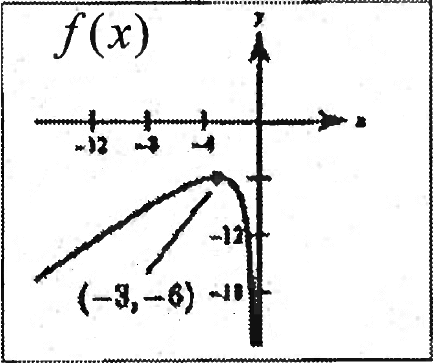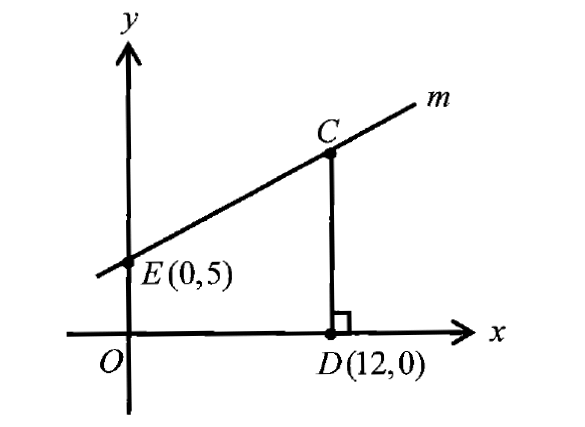DETERMINANT METHOD OF SOLVING LINEAR EQUATIONS
To solve system of linear equations in two variable, we use the following rules.
Rule 1 :
If ∆ ≠ 0. Then the system has unique solution and we can solve the equations by using the formula
x = ∆ₓ/∆ , y = ∆ᵧ/∆
Rule 2 :
If
∆ = 0 and ∆ₓ = 0, ∆ᵧ = 0
and at least one of the coefficients a11, a12, a21, a22 is non zero, then the system is consistent and has infinitely many solution.
Rule 3 :
If ∆ = 0 and at least one of the values ∆ₓ, ∆ᵧ is non-zero then the system is inconsistent and it has no solution.
Example 1 :
Solve the following equation using determinant method
x + 2y = 3, x + y = 2
Solution :
Write the values of Δ, Δx and Δy and evaluate
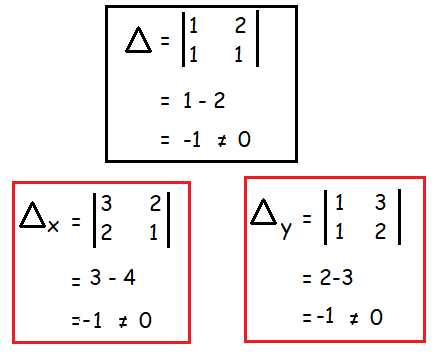
Here Δ ≠ 0, Δx ≠ 0 and Δy ≠ 0.
So, the system is consistent and it has unique solution.
x = Δx/Δ and y = Δy/Δ
x = -1/(-1) ==> 1
x = -1/(-1) ==> 1
Hence the solution is (1, 1).
Example 2 :
Solve the following equation using determinant method
3x + 2y = 5 and x + 3y = 4
Solution :
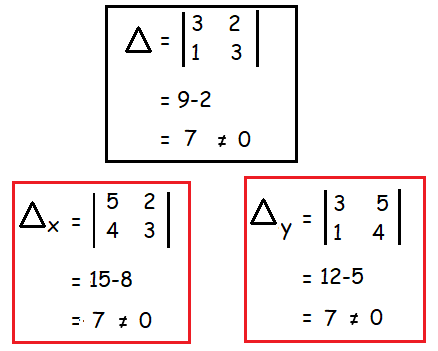
Here Δ ≠ 0, Δx ≠ 0 and Δy ≠ 0.
So, the system is consistent and it has unique solution.
x = Δx/Δ and y = Δy/Δ
x = 7/7 ==> 1
x = 7/7 ==> 1
Hence the solution is (1, 1).
Example 3 :
Solve the following equation using determinant method
x + 2y = 3 and 2x + 4y = 8
Solution :
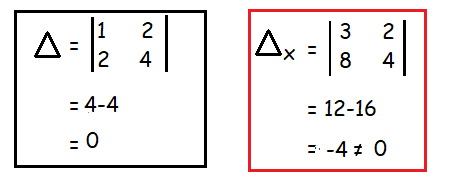
Here, Δ = 0 but Δx ≠ 0.
So, the system is inconsistent and it has no solution.
Example 4 :
Solve the following equation using determinant method
x + 2y = 3 and 2x + 4y = 6
Solution :
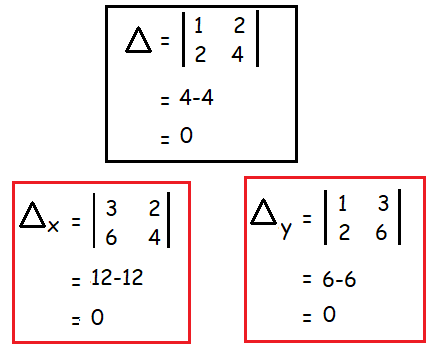
Since ∆ = 0, ∆ₓ = 0 and ∆ᵧ = 0 and atleast one of the element in ∆ is non zero.
Then the system is consistent and it has infinitely many solution. The above system is reduced into one equation. To solve this equation we have to assign y = k.
x+2y = 3
x+2(k) = 3
x+2k = 3
x = 3-2k and y = k
So, the solution is (3-2k, k). Here k ∈ R where R is real numbers.
Example 5 :
Solve the following equation using determinant method
2x+4y = 6, 6x+12y = 24
Solution :
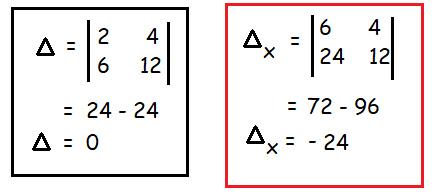
Here ∆ = 0 but ∆ₓ ≠ 0, then the system is consistent and it has no solution.
Example 6 :
Solve the following equation using determinant method
2x+y = 3 and 6x+3y = 9
Solution :
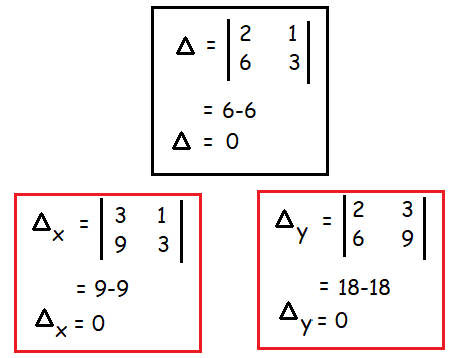
Since ∆ = 0, ∆ₓ = 0 and ∆ᵧ = 0 and atleast one of the element in ∆ is non zero. Then the system is consistent and it has infinitely many solution. The above system is reduced into single equation. To solve this equation we have to assign y = k.
2x+y = 3
2x+k = 3
2x+k = 3
2x = 3-k
x = (3-k)/2
y = k
So, the solution is ((3-k)/2, k). Here k ∈ R where R is real numbers.
Example 7 :
Solve the following system of linear equation using Cramer’s rule
x + 2 y + 3 z = 6, 2x + 4 y + z = 7, 3x + 2 y + 9z = 14
Solution :
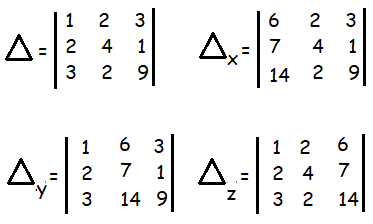
Δ = 1[36 - 2] - 2[18 - 3] + 3[4 - 12]
= 1(34) - 2(15) + 3(-8)
= 34 - 30 - 24
= 34 - 54
= -20
Δx = 6[36 - 2] - 2[63 - 14] + 3[14 - 56]
= 6[34] - 2[49] + 3[-42]
= 204 - 98 - 126
= 204 - 224
= -20
Δy = 1[63 - 14] - 6[18 - 3] + 3[28 - 21]
= 1[49] - 6[15] + 3[7]
= 49 - 90 + 21
= 70 - 90
= -20
Δz = 1[56 - 14] - 2[28 - 21] + 6[4 - 12]
= 1[42] - 2[7] + 6[-8]
= 42 - 14 - 48
= 42 - 62
= -20
x = Δx / Δ, y = Δy / Δ and z = Δz / Δ
x = -20/(-20), y = -20/(-20), z = -20/(-20)
x = 1, y = 1 and z = 1
Example 8 :
Solve the following system of linear equations using Cramer’s rule.
x + 2 y – z = 1, 3x + 8y + 2 z = 28, 4x + 9y + z = 14
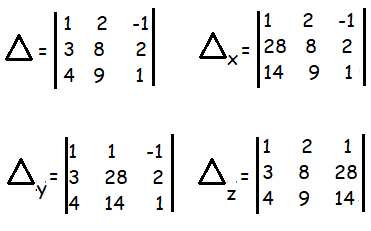
Δ = 1[8 - 18] - 2[3 - 8] - 1[27 - 32]
= 1(-10) - 2(-5) - 1(-5)
= -10 + 10 + 5
= 5
Δx = 1[8 - 18] - 2[28 - 28] - 1[252 - 112]
= 1(-10) - 2(0) - 1(140)
= -10 + 0 - 140
= -150
Δy = 1[28 - 28] - 1[3 - 8] - 1[42 - 112]
= 1(0) - 1(-5) - 1(-70)
= 0 + 5 - 70
= -65
Δz = 1[112 - 252] - 2[42-112] + 1[27 - 32]
= 1(-140) - 2(-70) + 1(-5)
= -140 + 140 - 5
= -5
x = Δx / Δ, y = Δy / Δ and z = Δz / Δ
x = -150/5, y = -65/5, z = -5/5
z = -30, y = -13, z = -1
Kindly mail your feedback to v4formath@gmail.com
We always appreciate your feedback.
©All rights reserved. onlinemath4all.com
Recent Articles
-
AP Calculus AB Problems with Solutions (Part - 11)
Feb 13, 25 09:24 AM
AP Calculus AB Problems with Solutions (Part - 11) -
AP Calculus AB Problems with Solutions (Part - 12)
Feb 13, 25 09:17 AM
AP Calculus AB Problems with Solutions (Part - 12) -
Digital SAT Math Problems and Solutions (Part - 110)
Feb 13, 25 12:08 AM
Digital SAT Math Problems and Solutions (Part - 110)
